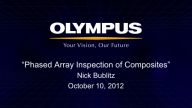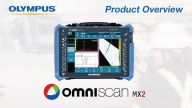复合材料的相控阵检测
Engineers are utilizing composite materials more and more in the design of many components due to their unique properties of high strength and low weight. Composites are inspected regularly with ultrasonics for delaminations and other discontinuities. Phased Array Ultrasound techniques offer several benefits including better detection, faster scanning, and auditable data files. This webinar will review the use of phased array ultrasound methods on composite structures at both the manufacturing and maintenance levels. Inspection equipment and techniques from manual to automated scanning for various flat and shaped CFRP (Composite Fiber Re-enforced Polymers) will be reviewed in detail.

Webinar - 复合材料的相控阵检测Narration Language:English

OmniScan MX2产品概述Narration Language:EnglishSubtitles Available:Chinese, English, French, German, Italian, 日本語, Portuguese, Russian, Spanish
您是否对视频中的产品和解决方案存在问题?
Questions and Answers
Q: What kind of system could be utilized for composite structure with honeycomb core to detect de-laminations, for example?
A: Ultrasound including phased array can be used on these structures; however the honeycomb can limit the extent of the testing. Another device/technique you may consider is the Olympus NDT BondMaster.
Q: How do transducer frequencies vary from those used in UT of typical metallic materials?
A: The most widely used frequencies are 3.5, 5, and 10 MHz. For weld testing with phased array we typically see 1 to 10 MHz as the most common range.
Q: Are operator 'certifications' similar or equivalent to those required for typical UT?
A: Certifications can vary. Typically conventional certification is required prior to Advanced Ultrasound certification. Typically for ASNT SNT-TC1A or Nas 410 80 hours of formal training is required on top of LII certification and also OJ hours are required.
Q: To inspect glass/epoxy composites from 0.5 mm up to 20 mm thick one would need low frequency transducers, e.g. 150 kHz. Is that possible with phased array probes?
A: Typically this is outside of most phased array instruments bandwidth. There are some specialty machines but this low of frequency is not typical.
Q: What are the thickness ranges both for CFRP and GFRP composites that OMNIScan can be used for?
A: I have personally seen these tests conducted with up to 2 inches of either material.
Q: How to measure thickness on the radii of a composite part (aircraft parts)
A: When doing the tests as detailed thickness measurements are readily available by gating the back wall and reading the measurement.
Q: How and where can I get trained and certified in phase array?
A: Please check out our training academy: http://www.olympus-ims.com/en/training-academy.
Q: Can you please demonstrate how to show the composite (3d) view of the c / b / d scans?
A: In the software the views can be selected. More advanced software is available in the market that allows 3D views but most base industrial software does not.
Q: What is the typical thickness range vs frequency when testing composites?
A: Using 3.5 to 10 MHz I have seen .035" to 2-3 inches tested personally.
Q: What is the minimum thickness you can inspect with this technique?
A: I have done tests in .035" composites.
Q: Is it possible for glass fibers to be inspected?
A: Yes, glass fibers can be inspected
Q: Would phased array inspection be able to identify more subtle things such as fiber direction (to identify if there are "waves" is a ply?
A: Possibly, I have seen wrinkle detection in GFRP. The test should be conducted to determine.
Q: For the defect location, I want to know if the software assumes the velocity is constant in composites?
A: Velocity can be input or calibrated. Under a routine test the software would assume one constant velocity.
Q: Can this also be used with GFRP?
A: Yes.
Q: In your experience what is the optimum frequency for PA inspection of glass fibre composites used in wind turbine blades? These also have a paint/Gelcoat on the surface.
A: 1 MHz is the most commonly used frequency I have seen for GFRP.
Q: Can you demonstrate how to utilize the binary function in TomoView to detect changes in dB and locate all other areas that fall within or out of that tolerance?
A: There is some basic info in the brochure here: http://www.olympus-ims.com/en/tomoview/. For more info you can contact us here: http://www.olympus-ims.com/en/contact-us/
Q: How about other materials other than composites? Can it still be used?
A: Yes, phased array is used for all types of metals, plastics, etc.
Q: Can it detect corrosion on fiber aluminum materials?
A: This is something we would want to test to be sure, it sounds reasonable from the description that it may be possible.
Q: Is there a special tool for T joints in composites where we would typically identify air trapped between the plies and the noodle/filler?
A: We may need more info on the test. You can contact us here: http://www.olympus-ims.com/en/contact-us/
Q: Does the Matlab integration tool come as a software package, or is it something that would be included in the software that comes with a PA unit such as MX2?
A: Data Access and Remote Control libraries are optional software sold on a software dongle for those customers needing this software.
Q: Did you test this technique in vertical position? Is it possible?
A: Yes, manually or with the right fixture it could be done vertically. The WING scanner may be an option: http://www.olympus-ims.com/en/scanners/wing-scanner/
Q: Any solutions to cover these smaller radii from 0.2 - 0.7" radius w/bubbler when we can't immerse a large part?
A: Please contact your technical representative to discuss possible options.
Q: No dead zone on a phased array probe? On the third slide please explain.
A: This is referring to in between the beams compared to a paint brush probe.
Q: Do all phased array transducers require a wedge? Even the 0 degree inspections?
A: Typically they are done with a wedge or a water column. Also, thin wear faces can be made or contact probes can be made which do not require a separate wedge.
Q: How do you simulate e.g. de-lamination defects? with foil? or do you have other possibilities?
A: There are many possibilities from EDM, FBH, paper/foil inserts, carbospheres, pillow inserts etc. Our Kennewick facility has expertise in composite standards, you can contact us here: http://www.olympus-ims.com/en/contact-us/
Q: What about soft wedges for NW2 and NW3 UT-PA Sensors for inspection where the surface is not relay flat?
A: A custom wedge may be able to be designed. You can contact us for more details: http://www.olympus-ims.com/en/contact-us/
Q: Do you have a special focus zone for the phased array probe or do you change it by choosing the focus depth? Where are the limits of a probe?
A: For basic applications the inspection is usually done unfocused. When focusing is desired it can be changed easily in the software. The limits of the probe relate back to the aperture size and frequency of the probe.
Q: Where can a technician go to get Phased array training for composites?
A: We have over 24 academy members worldwide: http://www.olympus-ims.com/en/training-members/
Q: Will there be more online presentations for phased array evaluations
A: Yes, we will announce new sessions regularly.